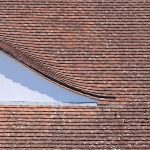
Ice dams are a common winter phenomenon that can cause significant damage to your roof and home if not properly addressed. These dams form when snow on the roof melts and then refreezes at the edge of the roof, creating a barrier that prevents water from draining properly. This trapped water can then seep under the shingles, causing leaks and water damage to the interior of your home.
The formation of ice dams is often the result of a combination of factors, including inadequate insulation and ventilation in the attic, fluctuating temperatures, and poor roof design. When warm air from the living space rises into the attic, it can cause the snow on the roof to melt. If the attic is not properly insulated, this melted snow can refreeze at the edge of the roof, creating a dam. Additionally, if the roof is not designed to shed water efficiently, this can also contribute to the formation of ice dams. Understanding these factors is crucial in preventing ice dams from forming and causing damage to your home.
The Dangers of Ice Dams: Potential Damage to Your Roof and Home
The dangers of ice dams cannot be overstated, as they can cause significant damage to your roof and home if left unchecked. One of the most immediate dangers of ice dams is the potential for water to seep under the shingles and into the interior of your home, causing leaks and water damage to ceilings, walls, and insulation. This can lead to costly repairs and mold growth if not addressed promptly.
In addition to water damage, ice dams can also put a significant amount of weight on your roof, which can lead to structural damage and even collapse in extreme cases. The weight of the ice dam combined with additional snowfall can exceed the load-bearing capacity of the roof, putting your home at risk. Furthermore, as the ice dam melts and refreezes, it can cause damage to the shingles and gutters, leading to further deterioration of your roof. It is important to be aware of these potential dangers and take proactive measures to prevent ice dams from forming in the first place.
Preventing Ice Dams: Tips for Keeping Your Roof and Gutters Clear
Preventing ice dams from forming in the first place is the best way to protect your roof and home from potential damage. One of the most effective ways to prevent ice dams is to ensure that your attic is properly insulated and ventilated. Adequate insulation will help to keep warm air from escaping into the attic and melting the snow on the roof, while proper ventilation will allow any heat that does enter the attic to escape, preventing the snow from melting in the first place.
In addition to insulation and ventilation, keeping your roof and gutters clear of snow and debris is crucial in preventing ice dams. Using a roof rake to remove excess snow from the roof can help to prevent the buildup of snow that can lead to ice dams. It is also important to keep gutters clear of leaves and other debris so that water can drain freely, reducing the likelihood of ice dams forming. By taking these proactive measures, you can significantly reduce the risk of ice dams forming and causing damage to your home.
Recognizing Signs of Ice Dams: How to Identify and Address the Problem
Recognizing the signs of ice dams is crucial in addressing the problem before it causes significant damage to your home. One of the most obvious signs of ice dams is the presence of icicles hanging from the edge of your roof. While icicles may look picturesque, they are actually a sign that water is not draining properly from your roof, which can lead to the formation of ice dams.
In addition to icicles, other signs of ice dams include water stains on ceilings and walls, as well as visible water dripping or leaking inside your home. If you notice any of these signs, it is important to address the problem promptly to prevent further damage. This may involve removing snow from the roof, clearing gutters, or taking steps to improve insulation and ventilation in your attic. By recognizing these signs and taking action quickly, you can prevent ice dams from causing extensive damage to your home.
Professional Repair Tips: Hiring a Qualified Contractor to Safely Remove Ice Dams
If you are dealing with a severe case of ice dams on your roof, it may be necessary to hire a qualified contractor to safely remove them. Professional contractors have the experience and equipment necessary to safely remove ice dams without causing further damage to your roof. They may use steam or hot water pressure washers to melt the ice dams and clear any remaining debris from your roof and gutters.
When hiring a contractor to remove ice dams, it is important to choose a reputable and experienced professional who is familiar with local building codes and safety regulations. Additionally, be sure to ask for references and proof of insurance before hiring a contractor to work on your home. By hiring a qualified professional to remove ice dams from your roof, you can ensure that the job is done safely and effectively, protecting your home from further damage.
DIY Solutions: Steps for Safely Removing Ice Dams on Your Own
If you are dealing with a minor case of ice dams on your roof, you may be able to safely remove them on your own using some simple DIY solutions. One effective method for removing ice dams is to fill a nylon stocking with calcium chloride ice melt and place it on the edge of your roof so that it crosses the ice dam and overhangs the gutter. This will create a channel for water to drain through as the ice melts.
Another DIY solution for removing ice dams is to use a roof rake to carefully remove excess snow from your roof. It is important to use caution when using a roof rake, as it can be dangerous if not used properly. Be sure to follow all safety guidelines and avoid standing directly beneath icicles or heavy snow as you work. By taking these DIY steps to remove ice dams from your roof, you can prevent further damage to your home and protect your roof from potential collapse.
Maintaining Your Roof: Long-Term Strategies for Preventing Ice Dams in the Future
In addition to addressing immediate concerns with ice dams, it is important to take long-term measures to prevent them from forming in the future. One effective long-term strategy for preventing ice dams is to ensure that your roof is properly designed to shed water efficiently. This may involve installing a drip edge along the edge of your roof or adding additional insulation in your attic to prevent heat from escaping into the space.
Regular maintenance of your roof and gutters is also crucial in preventing ice dams from forming in the future. This may involve clearing gutters of debris regularly, inspecting your roof for signs of damage or wear, and addressing any issues promptly before they lead to more serious problems. By taking these long-term measures to maintain your roof, you can significantly reduce the risk of ice dams forming and causing damage to your home.
In conclusion, understanding the causes and dangers of ice dams is crucial in protecting your home from potential damage. By taking proactive measures to prevent ice dams from forming, recognizing signs of their presence, and addressing them promptly, you can protect your roof and home from costly repairs and structural damage. Whether you choose to hire a professional contractor or take DIY steps to remove ice dams from your roof, it is important to prioritize safety and take action promptly to prevent further damage. By maintaining your roof and gutters regularly and taking long-term measures to prevent ice dams in the future, you can protect your home from potential damage and ensure its long-term stability.



